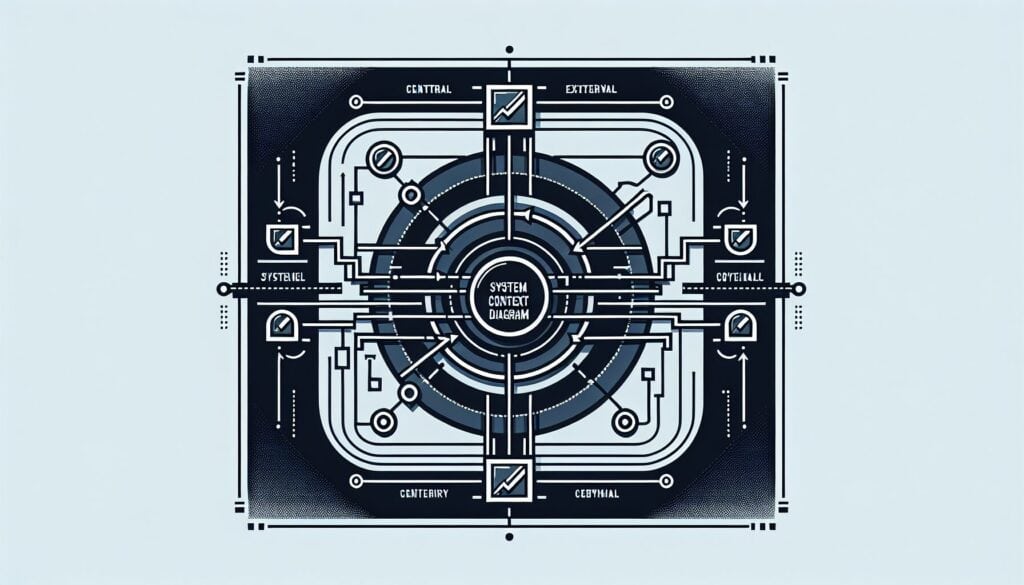Definire il confine tra un sistema e il suo ambiente, mostrando le entità che interagiscono con esso.
- Metodologie: Ingegneria, Ergonomia
Diagramma del contesto del sistema

Diagramma del contesto del sistema
- Metodologia agile, Mappatura dei processi, Gestione del progetto, Gestione della qualità, Progettazione del sistema, Esperienza utente (UX), Interfaccia utente (UI), Progettazione incentrata sull'utente
Obiettivo:
Come si usa:
- Un diagramma di alto livello che mostra il sistema come un singolo processo insieme ai suoi ingressi e uscite da/verso entità esterne (ad esempio, utenti, altri sistemi). Stabilisce l'ambito di ciò che deve essere incluso nel sistema.
Professionisti
- Semplice e facile da capire, anche per gli stakeholder non tecnici; definisce chiaramente l'ambito e i confini del sistema; aiuta a identificare tutte le interfacce esterne e gli stakeholder.
Contro
- Fornisce una visione di alto livello e manca di dettagli sul funzionamento interno del sistema; può essere troppo semplicistico per sistemi complessi; può non cogliere tutte le sfumature delle interazioni del sistema.
Categorie:
- Clienti e marketing, Ingegneria, Progettazione del prodotto, Gestione del progetto
Ideale per:
- Stabilire l'ambito di un sistema e identificare le interazioni e le interfacce esterne nelle prime fasi del progetto.
System Context Diagrams are widely utilized in various sectors including software development, engineering, and product management as a means to clarify the interactions between a system and its environment. They prove particularly advantageous during the early phases of a project when requirements are being gathered, allowing teams comprising project managers, system architects, and stakeholders to visually encapsulate the system’s exterior elements, including end-users, other systems, and data sources. Industries such as telecommunications, manufacturing, and healthcare frequently adopt this methodology to ensure that all stakeholders comprehend the designed system’s boundaries and responsibilities. For instance, in healthcare IT projects, a System Context Diagram can depict how a patient management system interacts with external databases and medical devices, thus facilitating a shared understanding among clinical staff and IT professionals. Participants in the process typically include interdisciplinary team members—such as business analysts who articulate business needs, engineers who provide technical feasibility assessments, and compliance officers who must ensure regulatory guidelines are met. This diagrammatic approach not only simplifies communication with non-technical stakeholders but also lays a solid foundation for further methodologies like Functional Decomposition and Use Case Analysis, ensuring that the project’s direction remains aligned with stakeholder expectations and requirements as it evolves through subsequent phases.
Fasi chiave di questa metodologia
- Identify the system to be modeled.
- Define external entities that interact with the system.
- Determine the inputs and outputs for the system.
- Draw the system as a single process in the diagram.
- Connect external entities to their corresponding inputs and outputs.
- Review the diagram for clarity and completeness.
Suggerimenti per i professionisti
- Involve stakeholders early to validate identified inputs and outputs, ensuring all relevant perspectives are captured.
- Utilize iterative reviews of the diagram as the project evolves to adapt to changing requirements and maintain clarity.
- Document assumptions made during diagram creation to provide context for future project phases and decision-making processes.
Leggere e confrontare diverse metodologie, raccomandiamo il
> Ampio archivio di metodologie <
insieme ad altre 400 metodologie.
I vostri commenti su questa metodologia o ulteriori informazioni sono benvenuti su sezione commenti qui sotto ↓ , così come tutte le idee o i link relativi all'ingegneria.
Contesto storico
1980
1980
1986
1987
1990
1990
1990
1980
1980
1986
1986
1987-03
1990
1990
1992
(se la data non è nota o non è rilevante, ad esempio "meccanica dei fluidi", viene fornita una stima approssimativa della sua notevole comparsa)















Post correlati
Simulazione di Monte Carlo
Test basati su modelli
Controllo del modello
Ricerca con metodi misti
A prova di errore (Poka-Yoke)
Test del profilo di missione